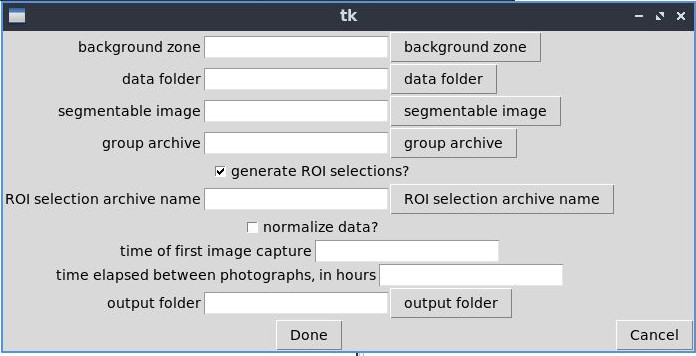An automated pipeline for analyzing arabidopsis luciferase imaging data.

- Download the
install-luc-linux64.shscript - run
install-luc-linux64.shin bash, e.g. by runningbash install-luc-linux64.sh - answer the prompts (one of the steps requires sudo/admin/root privledges)
- Download the
install-luc-win64.ps1script - Change the powershell execution policy to allow running scripts, e.g. by running
Set-ExecutionPolicy Bypassin powershell - Run
'install-luc-win64.ps1in PowerShell, e.g. by opening PowerShell and typing .\install-luc-win64.ps1 - Answer the prompts (one of the steps requires administrator privledges)
Run the run.sh script in bash, e.g. by running bash run.sh
Run the run.ps1 script in powershell
- Generate ROI objects to measure plants in the data from an image ( the first image is usually very bright relative to the rest of the sequence )
- measure the plant ROI brightness over the sequence of photographs (and therefore over time)
- process the data to (ideally) improve the signal to noise ratio
- correlate plant ROI objects with experimental group ROI objects by position, and use this to organize data by experimental group
- graph accumulated measurements
- The data is a timelapse/sequence of 16-bit grayscale images
- the images depict plates of (transgenic) arabidopsis plants that express luciferase production
- the plants have access to luciferin substrate (in the water or the growth media)
- the plants emit an amount of light that is detectable by the camera
- the only light sources in the images are either the plants themselves or reflections of their light
- the images cotain a region that is recognizably not data
- the plates in the images form one or more distinct experimental groups
- the time between photographs is fixed for the duration of the timelapse/sequence
- Fiji (ImageJ variant)
- Python 3 (programming language)
- numpy (n-dimensional array mathematic/manipulation library)
- matplotlib (graphing library)
- pyjnius (java to python interoperation library)
- OpenJDK (open-source java development kit)
- venv (virtual environment tool for Python)
- folder with sequence of images
- image (used for segmentation: division of image[s] into subject(data) and non-subject(background) zones)
- background (non-data area of image used for comparison, represented as ImageJ ROI object)
- groups (archive(zip file) containing list of areas (represented as ImageJ ROI objects) defining distinct experimental groups)
- whether to load or generate and save plant/data ROI objects
- filename of or for plant/data ROI objects
- whether to normalize the data (by dividing each subject ROI by its own maximum value)
- the time the first photograph was taken
- elapsed time between each photograph being taken
- aggregate graph organized by experimental group over time (average brightness on y-axis, elapsed time on x-axis)
- graph of each experimental group over time (individual brightness on y-axis, elapsed time on x-axis)
- graph of all individuals over time (individual brightness on y-axis, elapsed time on x-axis)